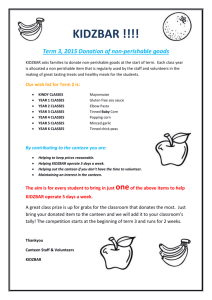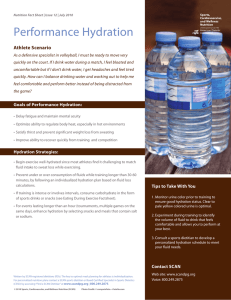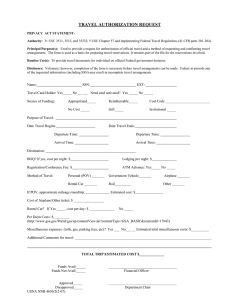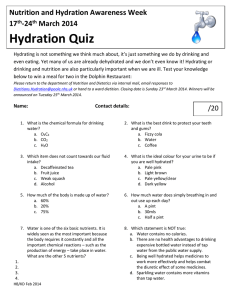firefighter hydration evaluation U.S. Department
advertisement
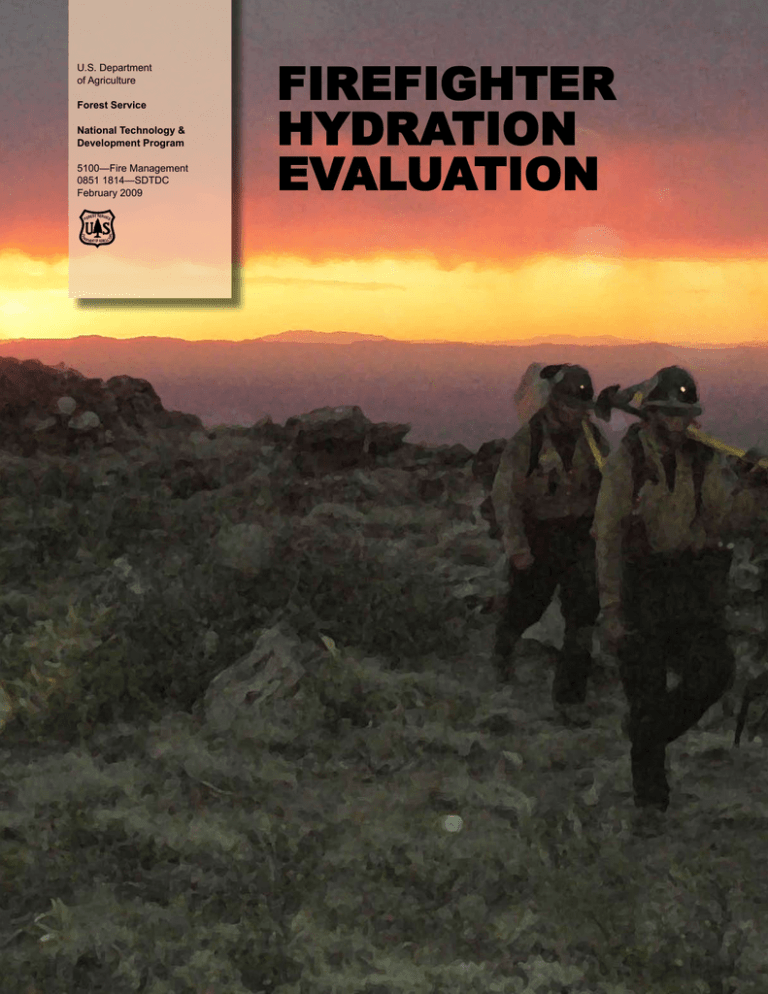
U.S. Department of Agriculture Forest Service National Technology & Development Program 5100—Fire Management 0851 1814—SDTDC February 2009 DE P A RT UR E EST SERVICE FOR MENT OF AGRIC U L T firefighter hydration evaluation Firefighter Hydration Evaluation Sam Wu—Mechanical Engineer George Broyles—Fire Project Leader Joshua Falls—Fire Program Student San Dimas Technology & Development Center San Dimas, California 91773 February 2009 Information contained in this document has been developed for the guidance of employees of the U.S. Department of Agriculture (USDA) Forest Service, its contractors, and cooperating Federal and State agencies. The USDA Forest Service assumes no responsibility for the interpretation or use of this information by other than its own employees. The use of trade, firm, or corporation names is for the information and convenience of the reader. Such use does not constitute an official evaluation, conclusion, recommendation, endorsement, or approval of any product or service to the exclusion of others that may be suitable. The U.S. Department of Agriculture (USDA) prohibits discrimination in all its programs and activities on the basis of race, color, national origin, age, disability, and where applicable, sex, marital status, familial status, parental status, religion, sexual orientation, genetic information, political beliefs, reprisal, or because all or part of an individual’s income is derived from any public assistance program. (Not all prohibited bases apply to all programs.) Persons with disabilities who require alternative means for communication of program information (Braille, large print, audiotape, etc.) should contact USDA’s TARGET Center at (202) 720-2600 (voice and TDD). To file a complaint of discrimination, write USDA, Director, Office of Civil Rights, 1400 Independence Avenue, S.W., Washington, D.C. 20250-9410, or call (800) 795-3272 (voice) or (202) 720-6382 (TDD). USDA is an equal opportunity provider and employer. table of contents Introduction .......................................................................................................... 1 Performance Testing................................................................................................. 4 Keeping the water cool................................................................................. 6 Durability...................................................................................................... 8 Compatibility with Existing PPE and Ease of Use.................................................. 12 Cost ........................................................................................................ 15 Conclusions and Recommendations...................................................................... 20 v introduction introduction Wildland firefighters, who work long hours in extreme terrain and weather conditions, must be properly hydrated. Many firefighters rely on plastic 0.95-liter canteens, supplied by the cache (NFES 0037), for hydration. While inexpensive and simple, these canteens have a history of complaints: they are not durable, caps are misplaced or pop off, and they do not keep the water chilled. Some crews have been experimenting with different bladder systems and water bottles (i.e., Nalgene), other than Government Services Administration (GSA) canteens. The National Technology and Development Program of the Forest Service, U.S. Department of Agriculture, was tasked with determining if the new hydration systems should be included in the national cache system to augment (or replace) the standard issue canteens. A team from the national technology and development center (we), located at San Dimas, California, began the study by developing and distributing a questionnaire to obtain information from field personnel regarding three basic hydration systems: the standard plastic canteens provided by GSA (figure 1), hydration bladder systems, and canteens and water bottles. Figure 1—GSA standard plastic canteen, 0.95 liter. We developed the questionnaire to assess different hydration systems to determine the durability of each system in the fire environment, the ease of maintenance, the effectiveness in providing cool water for extended periods of time in warm environments, and the compatibility with existing personal protective equipment (PPE). The questionnaire was given to several Interagency Hotshot Crews and engine crews. We also provided several different bottles and bladder systems to crews for field evaluation. 1 Firefighter Hydration Evaluation While individual products are not shown in figures 2, 3, and 4, the plots show the frequency of user ratings for each category. The plots show general trends in the perception of the different systems. For example, durability was seen to be greatest in the bottles (figure 3), but least in the GSA issued canteens (figure 2), while bladder systems (figure 4) were perceived as better than bottles and GSA canteens at keeping the water cool. GS A C anteen 6 6 55 Ratings 44 33 Ratings 22 11 00 Durability Ease of Upkeep Keeping Water Cool Integration with Pack Figure 2—GSA canteen. The size of the circle corresponds with the frequency of user ratings. User rankings are from 1 to 5, with 1 being poor performance and 5 being superior performance. For example, more respondents gave a rating of 1 in the “Keeping Water Cool” category than respondents who gave a rating of 4 in the same category. B ottles 66 55 Ratings 44 33 Ratings 22 11 00 Durability Ease of Upkeep Keeping Water Cool Integration with Pack Figure 3—Bottles. The size of the circle corresponds with the frequency of user ratings. User rankings are from 1 to 5, with 1 being poor performance and 5 being superior performance. For example, more respondents gave a rating of 5 in the “Durability” category than respondents who gave a rating of 4 in the same category. 2 B ladder Hydration S ys tems introduction 6 6 5 5 Ratings 4 4 3 3 Ratings 2 2 1 1 0 0 Durability Ease of Upkeep Keeping Water Cool Integration with Pack Figure 4—Bladder hydration systems. The size of the circle corresponds with the frequency of user ratings. User rankings are from 1 to 5, with 1 being poor performance and 5 being superior performance. For example, more respondents gave a rating of 4 in the “Integration with Pack” category than respondents who gave a rating of 5 in the same category. A visual comparison reveals the general attitude about the hydration systems across different categories. Durability is perceived as highest in bottles and lowest in the GSA canteen. Ease of upkeep (maintenance) is perceived as highest in bottles and lowest in the bladder systems. Keeping water cool is perceived as highest in the bladder systems and lowest in the GSA canteen. Integration with a GSA Blue fire pack (PPE) is perceived as highest in the GSA canteen and lowest in the bladder systems. Comments received from the field that accompanied the questionnaire included criticisms of all three hydration systems. Many respondents were concerned about (1) the GSA canteen caps breaking and coming off and (2) water becoming warm too quickly, which discouraged hydration. Their concerns for the commercially purchased bottles were (1) expense (required a personal purchase) and (2) they did not keep the water cool. Their concerns for the bladder hydration systems were maintenancerelated: (1) they got dirty quickly, (2) it was hard to judge how much water was left in the pack, and (3) it was difficult to integrate with existing line gear. 3 Firefighter Hydration Evaluation Performance Testing General guidelines were used to determine equipment and conditions of testing. In recent years, much media attention has spotlighted the use of Bisphenol-A (BPA)—a building block used in polycarbonate plastics—in sports bottles and other items. BPA has been suspected of causing chronic toxicity in humans—particularly in early development—and has been known to leach from polycarbonate plastics . While experts disagree on the dangers of BPA, the hydration systems industry has steered away from the controversy by using alternative materials. Consequently, all units tested in this study are BPA free. We selected nine 3-liter standard bladder hydration systems and four bottles/canteens for comparison. The selection was based on informal interviews and research on hydration systems commonly used in firefighting and hiking (figure 5). Also, field personnel often carry open-market fire packs with differing features and compartment sizes. For this project, the hydration systems were tested with the most current GSA blue fire pack. 4 performance testing Figure 5—Test products. (1) 1.9-liter military canteen by Skilcraft; (2) 0.95-liter military canteen by Skilcraft; (3) 0.75-liter Better Bottle by Camelbak; (4) 0.95-liter Widemouth Loop Top (HDPE) by Nalgene; (5) 3-liter Hoser by Platypus; (6) 3-liter Big Zip by Platypus; (7) 3-liter CXC Bladder by Nalgene (left), 3-liter TPE Bladder by Nalgene (right); (8) 3-liter Stinger cover and liner by Hydramax; (9) 3.5-liter Alpha cover and liner by Hydramax; (10) 3-liter Hydromedary, MSR; (11) 3-liter Unbottle by Camelbak; (12) 3.1-liter Hotshot by Camelbak 5 Firefighter Hydration Evaluation Keeping the water cool The first test determined how well the hydration system kept water cool in warm conditions. The water temperature was measured against the amount of time the system was in a fixed-temperature environment. Hydration systems—filled with 40 °F water and enclosed in blue fire packs—were placed inside an environmental chamber with a fixed temperature of 110 °F. Temperature readings were taken at 5-second intervals using type K thermocouples and recorded with LABView software. Figures 6, 7, and 8 show results of hydration systems plotted against the baseline, a 0.95-liter GSA standard-issue canteen. Tem p erature Ri s e for Bottles ver s us G S A Std iss u e C a nte e n s 110.0 110.0 105.0 105.0 100.0 100.0 0.95L Widemouth, 0.95LNalgene Wide m out h Bottle 95.0 95.0 Temperature (°F) 90.0 90.0 0.95L GSA Standard is canteen Bottle 0.75L Better Bottle, Camelbak 0.75L Bette r 0.95L GSA 0.95L GSA Standard Issue Canteen Cante en 0.95L Widemouth Nal gene 85.0 85.0 1.9LC Military 0.95L anteen Canteen, Skilcraft 80.0 80.0 Temp (*F) 75.0 75.0 0.75L Bette Bottle, Came lbak 0.95L 1 .9L CantMilitary een 70.0 70.0 Canteen, Skilcraft 65.0 65.0 0.95L Mi li Cante en, Skilcraft 60.0 60.0 55.0 55.0 50.0 50.0 1.9L Military Cante en, Skilcraft 45.0 45.0 40.0 40.0 35.0 35.0 0 0:00 1:00 1:00 2:00 2:00 3:00 3:00 4:00 4:00 Elapsed 5:00 5:00 Time (h 6:00 6:00 7:00 7:00 8:00 8:00 9:00 9:00 o urs)) Elapsed Time (hours) Figure 6—Temperature rise for bottles versus the 0.95-liter GSA standardissue canteen. 6 performance testing T emperature R is e for B ladder H ydration S ys tems vs G S A S td is s ue C anteens 110.0 110.0 101oz Zip 3L BigBig Zip, Platypus 105.0 105.0 100.0 100.0 1003L ozStinger Stingerliner, liner Hydramax 0.95L Standard Issue 16 oz GSA Canteen GSA Canteen 95.0 95.0 101 oz Unbottle, Camelbak 101 oz 3L Hydromedary, Hydromedary MSR Temperature (°F) 90.0 90.0 85.0 85.0 101 oz CXC Bladder, Nalgene 101oz CXC 3L CXC Bladder, Nalgene Bladder 80.0 80.0 16 oz Standard Issue Canteen, GSA 104 oz Hotshot, Camelbak 101 oz TPE Bladder, Nalgene 75.0 75.0 70.0 70.0 Temp (*F) 101 oz Big Zip, Platypus 101oz TPE 3L TPE Bladder bladder, Nalgene 65.0 65.0 101 oz Hoser, Platypus 60.0 60.0 55.0 55.0 3L Hoser, 101 oz Hoser Platypus 50.0 50.0 101 oz Hydromedary, MSR 120oz 3.5L Alpha liner liner, Hydramax 45.0 45.0 40.0 40.0 120 oz Alpha liner, Hydramax 3L 101oz Unbottle, Unbottle Camelbak 104Hotshot, oz 3.1L Camelbak Hotshot 100 oz Stinger liner, Hydramax 35.0 35.0 0:00 1:00 0 1:00 2:00 3:00 2:00 4:00 3:00 5:00 4:00 5:00 6:00 7:00 6:00 7:00 8:00 8:00 9:00 9:00 E l a p s e d T i m e (h o u rs ) Elapsed Time (hours) Figure 7—Temperature rise for bladder hydration systems versus 0.95-liter GSA standard-issue canteen. S elected B ladders and B ottles Data 110.0 110.0 105.0 105.0 0.95L Widemouth Bottle, Nalgene 100.0 100.0 0.95L Military Canteen, Skilcraft 0.95L Standard Issue Canteen, GSA 95.0 95.0 32 oz Widemou Bottle, Nalgene Temperature (°F) 90.0 90.0 16 oz Mili Canteen, Skilcraft 85.0 85.0 80.0 80.0 BOTTLES AND CANTEENS 75.0 75.0 70.0 70.0 Temp (*F) 3L Stinger liner, Hydramax 3L Hydromedary, MSR 60.0 60.0 55.0 55.0 104 oz Hotshot, Camelbak 3.1L Hotshot, Camelbak 40.0 40.0 35.0 35.0 0:00 0 101 oz Ho Platypus BLADDER SYSTEMS 3L Hoser, Platypus 50.0 50.0 1:00 1:00 2:00 2:00 3:00 3:00 4:00 4:00 5:00 5:00 6:00 6:00 7:00 7:00 8:00 8:00 9:00 9:00 E laps ed Time (hours ) Elapsed Time (hours) 101 oz Hydromed MSR 100 oz St liner, Hydramax 65.0 65.0 45.0 45.0 16 oz Standard Issue Canteen, Figure 8—Selected bladder and bottle data. 7 Firefighter Hydration Evaluation Test results show bottles were comparable to the 0.95-liter GSA canteen in thermal-heat transfer, but bladder systems insulated the water better. For bottles, the Nalgene Widemouth and the Camelbak Better Bottle were comparable to the 0.95-liter GSA canteen. However, the two military canteens from Skilcraft insulated the water slightly better. The Camelbak Hotshot and the Camelbak Unbottle bladder systems performed best. Table 1 shows the time required for each system to rise from 40 °F to 70 °F. It took the Camelbak Hotshot 6 hours to reach 70 °F, compared to 2 hours for the 0.95-liter GSA standard issue canteen. Please note: temperatures did not rise linearly with respect to time. A rise from 70 °F to 100 °F took 8 hours for the Camelbak and 3 hours for the GSA canteen. Table 1—Time required to rise from 40 °F to 70 °F Hydration System Time to 70 °F from a starting temp of 40 °F (in hours) Standard Issue 0.95L GSA Canteen 2:15 Widemouth Bottle, Nalgene 2:25 0.95L Skilcraft Military Canteen 2:45 Hydromedary, MSR 4:15 Stinger liner, Hydramax 4:25 Hoser, Platypus 4:40 Hotshot, Camelbak 6:10 Durability 8 The next tests determined the hydration system’s durability in a fire environment. Blue fire packs with hydration systems—filled 3/4 full—were loaded with 50-pound sandbags and dropped from 6 feet. The hydration system was removed from the pack and checked for signs of damage or wear. Table 2 shows the drop test results. performance testing Table 2—Six-foot drop test results. Hydration System Observations after 50-pound drop GSA canteen Widemouth Bottle, Nalgene Slight dent on top edge, no leaks. Better Bottle, Camelbak Top slightly misaligned, slight leak. Military Canteen, 0.95L, Skilcraft No noticeable effect. Military Canteen, 1.9L, Skilcraft No noticeable effect. CXC bladder, Nalgene Very slight distortion to seal on top of bag. One-half-inch rupture above articulated valve at bottom of the bag. Large bubbling at bottom of the bag, severely compromised. TPE bladder, Nalgene Large rupture along seams above the fill hole and slight bubbling and warping of material on bottom left of bag Big Zip, Platypus Zipper top blew open, large amount of water leakage. Hoser, Platypus Some bubbling at the seal on left side of bag, no leaks. Alpha, Hydramax No noticeable effects. Stinger, Hydramax No noticeable effects. Hydromedary, MSR No noticeable effects. Hotshot, Camelbak No noticeable effects. Unbottle, Camelbak No noticeable effects. Cap cracked on edges and popped off. Bottom corner of the canteen crumpled on impact. 9 Firefighter Hydration Evaluation Next, we placed the hydration systems in an environmental chamber and heated them for 1 hour at 155 °F. The test results are shown in table 3. The samples—excluding the systems that had failed the first test—were filled to 3/4-full capacity, inserted into the blue fire packs, and dropped again from 6 feet. The results are shown in table 4. Table 3—Observations from extreme temperature test Hydration System GSA canteen No noticeable effects. Widemouth Bottle, Nalgene No noticeable effects. Better Bottle, Camelbak No noticeable effects. Military Canteen, 0.95L, Skilcraft No noticeable effects. Military Canteen, 0.95L, Skilcraft No noticeable effects. CXC bladder, Nalgene Drinking tube completely compromised, becoming soft and viscous. TPE bladder, Nalgene Drinking tube completely compromised, becoming soft and viscous. Fill cap attachment point compromised, no longer offers a snug fit. Big Zip, Platypus No noticeable effects. Hoser, Platypus No noticeable effects. Alpha, Hydramax No noticeable effects. Stinger, Hydramax No noticeable effects. Hotshot, Camelbak No noticeable effects. Unbottle, Camelbak No noticeable effects. 10 Observation after extreme temperature performance testing Table 4—Observations after second drop test Hydration System Observation after second drop test GSA canteen Widemouth Bottle, Nalgene N/A Better Bottle, Camelbak N/A Military Canteen, 0.95L, Skilcraft No noticeable effects. Military Canteen, 1.9L, Skilcraft No noticeable effects. CXC bladder, Nalgene N/A TPE bladder, Nalgene N/A Big Zip, Platypus No noticeable effects. Hoser, Platypus No noticeable effects. Alpha, Hydramax No noticeable effects. Stinger, Hydramax No noticeable effects. Hotshot, Camelbak No noticeable effects. Unbottle, Camelbak No noticeable effects. Cap cracked on edges and popped off. The GSA plastic canteen failed both drop tests; the cap could not withstand the impact. The top of the Camelbak Better Bottle became slightly unaligned after the initial drop test causing slight leakage, possibly due to the design of the bottle. The Nalgene Widemouth bottle suffered a small dent in the cap but did not leak. During the initial drop test, both Nalgene bladders failed structurally—rupturing and developing bubbles in the seams. (See figures 9 and 10.) Rupture due to drop test Bubbling and distortion Figure 9—CXC bladder. Rupture above valve; distortion and bubbling at the bottom of the bag. 11 Firefighter Hydration Evaluation Figure 10— TPE bladder. Rupture above fill hole. The Nalgene hydration bladders’ drinking tube was the only item that was affected by the extreme temperature. The tubes became sticky and pliable and failed the test (figure 11). This Nalgene drinking-tube failure was possibly polymer-related. Nalgene drinking tubes are made from polyethylene rather than polyurethane that is used in most other brands. Figure 11—Structural failure of CXC and TPE bladder drinking tubes after the high temperature test. Compatibility with Existing PPE and Ease of Use 12 Table 5 provides a quick reference to the compatibility of each hydration system with the current GSA blue fire pack. compatibility with existing ppe and ease of use Table 5—Compatibility reference guide Hydration System Compatibility and Ease of Use GSA canteen Fits inside GSA blue fire pack side pouches. Fill opening of 1.2 inches does not allow easy access for filling or cleaning. Widemouth Bottle, Nalgene Fits inside side pouches of GSA blue fire pack. Fill opening is 2 inches. Better Bottle, Camelbak Fits inside side pouches of GSA blue fire pack. Fill opening is 2 inches. Hydration bite valve allows drinking operation for hydration ease. Military Canteen, 0.95L, Skilcraft Fits inside side pouches of GSA blue fire pack. Fill opening of 1-inch does not allow easy access for filling or cleaning. Military Canteen, 1.9L, Skilcraft Diamond shaped canteen. Does fit the side canteen pockets in GSA fire packs but is more difficult to take out. Fill opening of 1-inch does not allow easy access for filling or cleaning. CXC bladder, Nalgene 17-inch-long (7.75-inch-wide) body makes integration with GSA fire pack difficult. May fit well with commercial fire packs that include thinner, taller hydration bladder compartments. Fill opening 2 inches. TPE bladder, Nalgene 16-inch-long (7.25-inch-wide) body makes integration with GSA fire pack difficult. Side location of drinking tube quick-connect also possibly problematic for fit. Fill opening 2 inches. Big Zip, Platypus 17-inch-long (7.5-inch-wide) body makes integration with GSA fire pack difficult. May fit well with commercial fire packs that include thinner, taller hydration bladder compartments. Large fill opening has a zipper. Hoser, Platypus 17.5-inch-long (7.5-inch-wide) body makes integration with GSA fire pack difficult. May fit well with commercial fire packs that include thinner, taller hydration bladder compartments. Fill opening of 0.8-inch does not allow easy access for filling or cleaning. Alpha, Hydramax 15-inch-long (8.5-inch-wide) body is the shortest of the bladder reservoirs tested, but least collapsible. For proper operation, the reservoir must be oriented with the fill spout/drinking tube at the bottom, making integration with the pack difficult. Fill opening of 1-inch does not allow easy access for filling or cleaning. Stinger, Hydramax 18-inch-long body (7-inch-wide) is longest of the tested bladder reservoirs, making integration with GSA fire pack difficult. May fit well with commercial fire packs that include thinner, taller hydration bladder compartments. Fill opening 2 inches. 13 Firefighter Hydration Evaluation Table 5—Compatibility reference guide (continued) Hydration System Compatibility and Ease of Use Hydromedary, MSR 17.5-inch-long (7.5-inch-wide) body makes integration with GSA fire pack difficult. May fit well with commercial fire packs that include thinner, taller hydration bladder compartments. Fill opening 2 inches. Hotshot, Camelbak 16-inch-long (9-inch-wide) body makes integration with GSA fire pack difficult; however, the reservoir does completely fit into the pack. May NOT fit well with commercial fire packs that include thinner, taller hydration bladder compartments. Fill opening 2 inches. Unbottle, Camelbak 18-inch-long (7.5-inch-wide) body makes integration with GSA fire pack difficult. May fit well with commercial fire packs that include thinner, taller hydration bladder compartments. Fill opening 2 inches. All of the bottle/canteen products we tested fit in the side pockets of the GSA blue fire pack. The hydration bladders can be carried in a pouch in the main storage area. However, the maximum height of the pouch is 16.5 inches. Most hydration systems tested were long and narrow, making integration with the GSA fire pack difficult. With the exception of the Alpha liner, they can be made to fit. The Camelbak Hotshot fits best. Its short length is made up by its expanded girth, which may too wide to fit in commercial fire packs with a narrow hydration storage area. We only tested 3-liter bladder hydration systems for this study; if a similar system with a smaller capacity were used, it should fit better. An alternate configuration for incorporating hydration systems is to attach the system to the outside of the fire pack. While this would allow any size hydration reservoir to be integrated with PPE, hydration bladder systems with exterior insulating sheaths, such as the Camelbak Hotshot, would be expected to perform particularly well. Bottles and canteens with built-in loops can be fixed onto the exterior of the fire pack with carabiners as well. 14 compatibility with existing ppe and ease of use Bottles, canteens, and bladder reservoirs have either a 1-inch or 2-inch fill opening. The size of the fill opening is important for several reasons. Firefighters may fill hydration systems using a hose or a cubie; if the fill opening is too small, it is difficult to fill the hydration system accurately. In some cases, engine crews may fill hydration systems with ice. A 1-inch fill opening makes adding ice difficult, while a 2-inch fill opening is more user friendly. Furthermore, cleaning hydration systems is easier with a larger fill opening. Cost Cost was one of the final considerations taken into account when recommending including a new hydration system in the GSA Fire catalog. The current GSA plastic canteens cost about $0.43 each and are sold for $0.57 each. Over the last 3 years more than 218,000 bottles have been purchased from GSA. In 2007, there were between 150,000 and 200,000 Federal and contract firefighters. In the best case scenario—where bottles are distributed to Federal firefighters only—this would equate to 14 bottles per year per firefighter, or $7.98. Table 6 shows the unit cost for hydration systems tested for this project. Based only on cost, the current GSA canteens are the least expensive alternative. It is likely that one hydration bladder system would be enough for a firefighter, they would also need several bottles to ensure that sufficient water and electrolyte-enhanced fluids are carried for the duration of the shift. Accessories, such as cleaning brushes, additional tubes, and bite valves, further add to the user’s annual cost. 15 Firefighter Hydration Evaluation Table 6—Hydration systems - unit cost Brand Model Capacity (Liters) Market Cost (per unit) GSA Cost (per unit) Camelbak Unbottle 3 $35.00* - Camelbak Hotshot 3.1 $57.00 $28.50-$39.03 ** Camelbak Bottle 0.75 $14.00 - Platypus Big Zip 3 $28.95 $15.45 Platypus Hoser 3 $22.95 $10.75 Hydramax Alpha liner 3.5 $20.80 $18.92 Hydramax Stinger liner 3 $20.00 - Mountain Safety Research Hydromedary 3 $36.95 Nalgene CXC Big Bore Tanker 3 $27.00 - Nalgene TPE Big Bore Tanker 3 $25.00 - Wide-mouth HDPE loop-top bottle 0.95 $3.68 Nalgene $20.78 $3.68 Skilcraft Canteen 0.95 $6.48 $1.70-$3.95 Skilcraft Canteen 1.9 $11.49 3.79 GSA Standard issue canteen 0.95 - $0.57 Notes * This is the price of the whole unit. Replacement bladders for the 3L Unbottle - $30 MSRP ** This is the price of the whole unit. Replacement bladders for the 3.1L Hotshot - $34 MSRP; $20.22 GSA (#90362) 16 There is, however, a benefit to carrying a wider variety of hydration systems. Hydration systems tend to be more durable, carry more water per unit, and have better thermal insulation. Hydration bladders allow users hands-free access water. Bottles are longer lasting than current GSA canteens, and may not need to be replaced for several seasons. Furthermore, using more durable hydration systems reduces the waste generated from GSA plastic canteens and bottled water. Table 7 provides a brief assessment of each product. compatibility with existing ppe and ease of use Table 7—Product assessments Hydration System Assessment Recommended GSA canteen Extremely low cost and structurally sound under high temperatures. Field personnel enjoy using as a disposable item. However, the low price comes with a cost to durability. On impact, the cap and body can be fractured or distorted. The cap is not connected with the body and can be lost easily. Small size means that three canteens are needed to carry 3 liters of fluid. Disposable canteens mean more waste. The 1.2-inchdiameter fill opening does not allow easy access for cleaning or filling. No, but may still need to be used in the cache system Widemouth, Nalgene HDPE widemouth bottle reviewed. Low cost, this bottle is the cheapest alternative bottle reviewed. Offers thermal insulation performance comparable with the GSA canteen. Bottle is impact resistant. The 2-inch-diameter opening allows easy access for cleaning and filling. Yes Better Bottle, 0.75L -Camelbak Thermal insulation performance comparable with GSA canteen. The bottle itself is impact-resistant but the design of the top may expose elements to possible failure on impact. Bite valve can get dirty easily. The 2-inch-diameter opening allows easy access for cleaning and filling. No Military canteen, 0.95L, Skilcraft Thermal insulation performance on par with GSA canteen. Canteen is impact-resistant. The 1-inch fill opening makes cleaning and filling difficult. No Military canteen, 1.9L, Skilcraft Diamond shape unwieldy for use in field. Canteen is impact resistant. The 1-inch fill opening makes cleaning and filling difficult. No CXC bladder, Nalgene Thermal insulation performance was second worst of the bladders tested. The CXC bladder failed the drop test, rupturing near the articulated tube valve. The 2-inch fill opening provides easy access for cleaning and filling. Complaints have been fielded of leakage around the articulated tube valve and quick-connect fitting although this was not verified in testing. No 17 Firefighter Hydration Evaluation Table 7—Product assessments (continued) Hydration System Assessment Recommended TPE bladder, Nalgene Thermal insulation performance was fair. The TPE bladder failed the drop test, developing a large rupture at the top seam. The 2-inch fill opening provides easy access for cleaning and filling. Location of quick connect on side of bag may prove problematic for fire packs with a narrow hydration reservoir pocket. Complaints have been fielded of leakage around the articulated tube valve and quick-connect fitting although this was not verified in testing. No Big Zip, Platypus Least expensive bladder tested. The zip-close fill opening allows for the easy entry of the bladders and thus, for ease of cleaning and filling. However, it offered the worst thermal insulation and it failed the drop test. No Hoser, Platypus Offers fair performance for thermal insulation along with an impact-resistant bag. The 0.8-inchdiameter fill opening does not allow easy access for cleaning or filling. No Hydromedary, MSR Offers fair thermal insulating performance and an impact-resistant bladder. The 2-inch fill opening provides easy access for cleaning and filling. Fill cap is not connected to the hydration reservoir and may get lost or misplaced. No Hotshot, Camelbak Offers the best thermal insulating performance and an impact-resistant bladder. Fits the GSA blue fire pack. The most expensive unit tested. The 2-inch fill opening provides easy access for cleaning and filling. Bite valve comes with a dirtresistant covering. The Hotshot was the only unit tested with an insulated tube covering. Yes Unbottle, Camelbak Offers good thermal insulating performance and an impact-resistant bladder. Fit is difficult with a GSA blue fire pack, but may work better with commercial fire packs with longer hydration reservoir storage areas. The 2-inch fill opening provides easy access for cleaning and filling. Yes 18 compatibility with existing ppe and ease of use Table 7—Product assessments (continued) Hydration System Assessment Recommended Alpha liner, Hydramax Stiff body is blow molded and provides fair insulating properties and is resistant to impact. The body is stiffer than competing bladders and may make integration with existing PPE difficult, particularly due to orientation of the fill spout/ drinking tube on the bottom of the reservoir. Has a larger storage capacity than most competitors at 3.5 liters. The 1-inch-diameter fill opening does not allow easy access for cleaning or filling. No Offers fair insulating properties and is resistant to impact. The 2-inch fill opening provides easy access for cleaning and filling. Fit is difficult with a GSA blue fire pack but may work better with commercial fire packs with longer hydration reservoir storage areas. Yes Stinger liner, Hydramax 19 Firefighter Hydration Evaluation Conclusions and Recommendations We evaluated 13 bladder systems and bottles for thermal insulation and durability to determine the best hydration systems for wildland fire environments. We compared the test results with those for GSA plastic canteens. The results generally followed user feedback; the bladder systems do keep water temperatures cooler for a period of time; and some bottles do appear to withstand abuse and impact. SDTDC recommends that two bottles and three bladder systems be introduced into the GSA fire catalog as consumable items to test the demand from the field. If the quantity of orders is particularly low on a product, that product can be phased out. While it may be technically possible to introduce the hydration bladders as a cache item, we feel that this action is not appropriate. The bladder hydration system is both time-consuming and difficult to wash on a mass-scale basis and there might be potential liability issues. As a consumable item in the catalog, the bladder hydration systems should be offered with cleaning accessories. A service life of 1 year is reasonable. Only the reservoir of the Camelbak Hotshot needs to be replaced annually, thereby reducing the overall cost as the insulated case would last several years. Although not tested in this evaluation, its insulated bladder system may have additional benefits for firefighters; the cooler water it provides may help reduce the firefighter’s core body temperature. Although we recommended only one alternative bottle/canteen, we suggest adding the 0.95-liter Nalgene Widemouth to the catalog as well. The thermal insulation should be similar to the other bottles (should not perform worse) and it should pass both the drop test and extreme temperature test. Bottles need to remain available for firefighters to use with electrolyte drinks because bladder systems are recommended to be used only with water due to concerns about microbial growth. Other hydration systems that may require testing in the future include Klean Kanteen bottles (stainless steel), Sigg bottles (aluminum), and the Camelbak Storm (similar to the Hotshot but with a narrower body). 20 conclusions and recommendations Additional durability testing could include abrasion testing, drinking hose connection tension testing, or puncture testing. A final note regarding the GSA plastic canteen: even though our tests revealed how poorly the canteen performed in relation to other hydration systems, we still recommend its use. A cache-item hydration system is necessary, and the GSA canteens provide a low cost temporary solution. Firefighters who use alternate bottles and reservoirs may still take along the plastic canteens as another backup water source. SDTDC thanks Missoula Technology and Development employees Brian Sharkey, Leslie Anderson, and Joe Domitrovich for their review of this publication. SDTDC’s national publications are available on the Internet at: http://www.fs.fed.us/eng/pubs/ Forest Service and U.S. Department of the Interior, Bureau of Land Management employees also can view videos, CDs, and SDTDC’s individual project pages on their internal computer network at: http://fsweb.sdtdc.wo.fs.fed.us/ For additional information on Firefighter Hydration, contact Sam Wu at SDTDC. Phone: 909–599–1267 ext 292. E-mail: swu@ fs.fed.us 21

